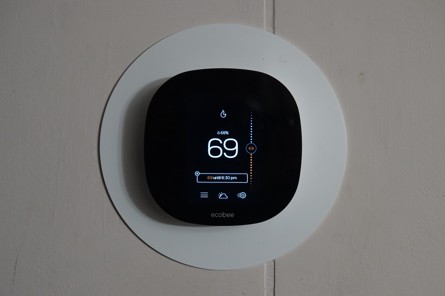Setting colder AC temperatures during summer can increase your overall home comfort. But too high, and you’ll instead have lowered HVAC’s efficiency and higher energy consumption.
Choosing the right setting is key to reducing energy bills, which makes it important to know what the best AC temperature settings should be during the hot seasons. However, there is no specific AC temperature setting due to weather variations.
Most homeowners set their air conditioners at 780 Fahrenheit during summer, but while this temperature balances comfort and energy efficiency, it’s better to make sure your AC is set to the right setting on a day-to-day basis so you won’t have high electricity bills at the end of the season. We’ll show you how to set AC temperatures for summer months that make sure you’re comfortable and saving on bills.
What Is The Best Air Conditioner Temperature?
While it is easy to tell the temperature to set for your home at a particular time, you cannot get one temperature setting for all HVACs. This is because the AC settings depend on factors like;
1. Number of People in Your Home
You will want to raise or lower your home’s temperatures depending on the number of people in the room. For example, the rooms could be warm and humid if you have many guests in your home.
Having several individuals in the room makes it feel that much hotter, and there’s usually an actual increase in humidity, making the air denser and hard to breathe. To make the rooms comfortable, homeowners should lower the HVAC temperatures and use a dehumidifier to reduce the humidity.
2. Humidity
Another factor you cannot ignore when setting your AC’s temperatures is humidity levels. High humidity in the room makes the place warmer. Although the air conditioner could cool the room, running it in high moisture does not yield tremendous benefits.
What’s A Good Temperature For AC?
Setting the AC at the wrong temperatures could cost you more energy bills. Therefore, homeowners should find the best temperature setting that keeps their houses and families comfortable and uses affordable energy.
The Department of Energy recommends 78 degrees. At that temperature, the air conditioner provides cooling while also saving energy. However, if this temperature makes the rooms too hot, you can reduce it to 75 degrees or lower.
Still, if 78 degrees is too cold for your room, you can go for a higher setting. Play with your AC temperature setting until you get the most comfortable one for the home. Ensure you also consider other energy-saving tips when searching for the best temperatures.
Set a Higher Temperature on Your Thermostat When You Are Away
You don’t want to pay high energy costs at the end of the month, so you must also know the best settings for your thermostat. Most homeowners get tempted to switch off the AC to stop energy consumption, which is not advisable.
Switching off the AC could result in too high temperatures in the house that the air conditioner will consume too much energy to cool. Instead, adjust the thermostat to higher degrees than what you set when you are at home. For example, you could increase the temperature by 7-10 degrees more than the current reading.
Also, when finding an average AC temperature, avoid setting the thermostat in colder settings to cool the home faster. The air conditioner will take the same time to cool the house but will consume more power.
Homeowners can avoid these cooling mistakes by getting programmable or smart thermostats. You can set these thermostats to raise or lower the temperatures when you are away and reset them before returning.
Other Ways to Improve Your AC Efficiency and Save Energy
Getting the correct energy settings for your AC is one way to save energy. However, try these other methods to ensure your energy bills remain low.
1. Clean the Vents
AC vents attract dust and debris, and leaves and tree branches could also block them. When this happens, the vents won’t allow free air circulation in the system, reducing its effectiveness.
When the air conditioner does not function properly, it causes strain on some mechanical parts, which consume a lot of energy. You will pay high energy bills due to an ineffective system.
To keep your energy bills constant, clean your vents regularly, or replace them to ensure continuous airflow in the HVAC. When buying new vents, buy the best quality and the correct size for your system.
2. Check for Leaks in the Attic and Windows
Your doors and windows conditions will contribute to your home’s energy efficiency. For example, broken windows allow drafts into the rooms, making them cooler than usual. This forces homeowners to keep their HVAC running all day to maintain comfortable room temperatures.
To keep your room’s temperatures steady, ensure you repair any cracks in the attic, doors, and windows. You can also replace the old units with new energy-efficient ones made of wood or fiberglass.
3. Use Fans
Instead of cooling your home with the air cooling system every time the temperature rises, you can use a ceiling or portable fans to cool. These use little energy than the HVAC. Remember to turn off the fans before leaving home to conserve more energy.
4. Maintain Your HVAC
Hiring an expert to inspect your heating and cooling system twice every year seems expensive, but it is necessary. During the inspection, the expert will examine the condition of the mechanical parts and advise on those that need replacement.
HVAC professionals should also check the vents and filters and clean them to ensure the machine’s efficiency. It helps the air conditioning system run smoothly and spend the right energy. Repairing the mechanical parts before severe damage also extends your machine’s lifespan.
5. Keep Your Thermostat Away From Heat
Your air conditioner’s efficiency depends on the positioning of your thermostat. Homeowners should keep it away from other hot appliances or walls that get direct sunlight from outside.
For example, avoid installing thermostats next to a sunny window or near lamps and cookers. It will give the wrong temperature readings and think it needs to cool the room. This leads to the improper usage of the AC, increasing energy bills.
Final Words
Since getting the best AC temperature for all homes is almost impossible, homeowners should set their thermostats to the temperatures they are comfortable with. It is also advisable to use other means of cooling like fans and energy-efficient windows and doors to reduce energy bills.





